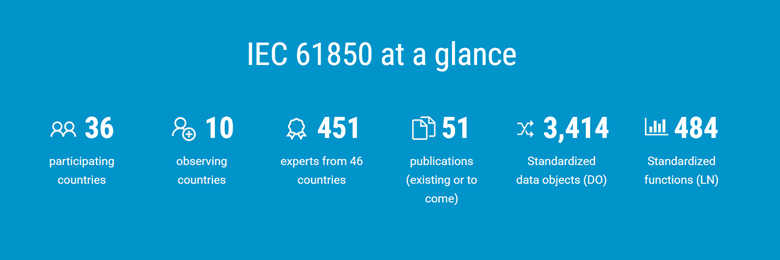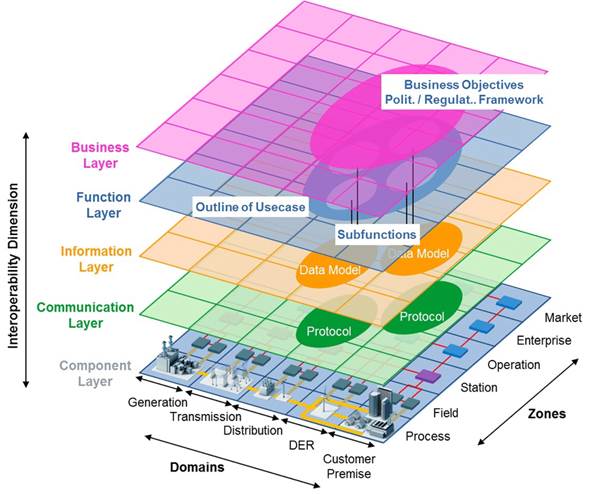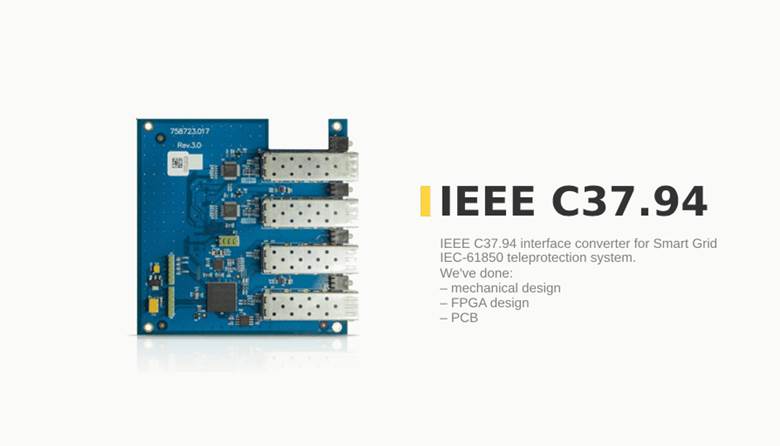IEC 61850 and Seamless Energy Management: Bridging the Gap Between Hardware, Software, and Smart Grids


The IEC 61850 standard for communication networks is a globally recognised standard essential in modern power utility automation. IEC 61850 establishes communication protocols for the integration of IEDs (intelligent electronic devices) within substations. It ensures communication between various components of electrical substations, thereby enhancing the performance of energy management systems.
The IEC 61850 protocol is essential for attaining connectivity, mobility, and durability in automation systems. It is becoming more and more important to be able to unify communication across a variety of devices as industries incorporate digital and smart technology. To maintain the integrity and effectiveness of contemporary operations, this standard supports the automation of complicated processes and makes sharing information in real-time easier.
At Promwad, we specialise in power utility automation solutions that align with the IEC 61850. Our experience includes schematic and PCB design, firmware, FPGA and embedded Linux development, all of which have helped our clients fully leverage the benefits of the IEC 61850 protocol.
Table of contents
The benefits of IEC 61850 in power utility automation
IEC 61850 or IEC 60870: what is the most appropriate standard for microgrid?
What is IEC 61850?
IEC 61850 serves as a comprehensive framework that governs the design, implementation, and integration of SAS (substation automation systems). The purpose of IEC 61850 is to standardise the communication between IEDs within substations for interoperability and more efficient and reliable operation of power systems.
One of the key components of this standard is the IEC 61850 communication protocol, which facilitates the exchange of data between devices in a substation. This protocol supports real-time monitoring, control, and protection functions. A notable feature within this protocol is the IEC 61850 MMS protocol (manufacturing message specification), which is used for the exchange of non-time-critical data, such as configuration settings, event logs, and diagnostic information.

The IEC 61850 standard is widely used in the wind energy industry to facilitate efficient communication between various components in wind power plants
Additionally, IEC 61850 introduces a hierarchical data model that standardises the representation of devices and functions within a substation. This model is based on logical nodes that show different aspects of the substation’s operation, such as protection relays, circuit breakers, and transformers. The standard also includes a flexible and extensible configuration language SCL (substation configuration language) for the detailed specification of how devices should interact within the system.
The benefits of IEC 61850 in power utility automation
One of the standout benefits of the IEC 61850 standard is its ability to promote interoperability between devices and systems from different manufacturers. This is achieved through the standardised IEC 61850 communication protocol, which ensures that devices can work together, regardless of the brand or model.
Moreover, IEC 61850 is highly flexible, allowing it to be adapted to various industrial applications beyond just substation automation. It could be power generation, distribution, or industrial process automation. This adaptability guarantees that as industries evolve and new technologies emerge, IEC 61850 can continue to serve as a foundational standard, supporting both current and future power utility automation requirements.

The IEC 61850 standard in figures. Source: IEC 61850 official website, iec61850.dvl.iec.ch
Another advantage of IEC 61850 is its ability to enhance system efficiency and reliability. The standard facilitates faster communication and more reliable data exchange between devices, which is critical in environments where real-time data is essential for monitoring and control. By enabling high-speed, low-latency communication, IEC 61850 ensures that industrial systems can respond quickly to changes and operate more efficiently.
IEC 61850 or IEC 60870: what is the most appropriate standard for microgrid?
When selecting the best standard for microgrid communication and automation, the decision often boils down to choosing between IEC 61850 and IEC 60870. Both standards serve important roles in the automation of power systems, but they cater to different needs and contexts.
IEC 61850 is typically the preferred choice for microgrids, particularly those incorporating renewable energy sources and requiring high-speed, real-time communication. This standard was initially developed for substation automation but has since evolved to support broader smart grid applications, making it ideal for the complex environment of a microgrid. It is suitable for distributed energy resources, energy storage systems, and demand response mechanisms.

Smart grid architecture model (SGAM) with interoperability layers. Source: IEC 61850 official website, iec61850.dvl.iec.ch
On the other hand, IEC 60870 is a well-established standard, widely used in traditional SCADA systems for controlling and monitoring power systems at a higher level, such as between control centers and substations. It is reliable in grid automation, but less suited to the demands of modern microgrids that require more granular, real-time control and data exchange.
IEC 60870 is generally better suited to simpler, more static energy systems where the communication network is less demanding in terms of speed and data handling. The IEC 60870-5-101 protocol (or IEC 101 protocol) is an international standard for telecontrol and monitoring in electrical engineering and automation systems, particularly in power systems. It is widely used in SCADA systems for communication between control centers and RTUs (remote terminal unit) or IEDs.
Also, part of the IEC 60870 series is the IEC 60870-5-103 protocol, a standard for the transmission of telecontrol data in electrical and automation systems, designed for communication between protective equipment and control systems in electrical substations.
In summary, for microgrids that need to integrate advanced, real-time communication and automation – especially those incorporating renewable energy sources – IEC 61850 is typically the more appropriate standard. IEC 60870 remains relevant for more traditional energy systems or where simpler automation solutions are sufficient.
What Promwad offers
Custom development
We specialise in developing custom solutions that fully follow the IEC 61850 standards. We understand the complexities involved in integrating IEC 61850 with existing automation systems, which is why we take a tailored approach to each project.

IEEE C37.94 multiplexer for Smart Grid IEC-61850 teleprotection system
Our expertise in smart grid protocols and power monitoring allows us to develop and implement solutions that are compliant with IEC 61850.
Consulting and сompliance support
In addition to our development and integration services, Promwad offers consulting support to help our clients achieve full compliance with the IEC 61850 standard. Our team provides expert guidance throughout the entire process, from initial assessment to implementation. We work closely with our clients to ensure that their systems meet all necessary requirements, helping them avoid costly errors and delays.
Promwad’s expertise extends to testing and validating systems to ensure they adhere to IEC 61850 protocols. We use different testing methodologies and tools to check that every component of your system is functioning correctly and is fully compliant with the standard. Our consulting services are particularly valuable for clients in building automation systems, where compliance with IEC 61850 is critical for operational success.
Use cases of IEC 61850 implementation
These examples highlight the versatility and effectiveness of IEC 61850 in various power utility automation scenarios, demonstrating its value in ensuring efficient and reliable operations across different sectors.
- Smart grid integration
A major utility company implemented IEC 61850 across its substations to streamline communication between different devices and enhance the reliability of its smart grid operations. By adopting the IEC 61850 protocol, the company achieved real-time data exchange and improved system-wide automation, leading to more efficient energy distribution and reduced downtime during maintenance.

The IEC 61850 standard is well-suited for both small and large-scale solar installations
- Renewable energy project
In a large-scale wind farm project, IEC 61850 managed and controlled the communication between wind turbines, substations, and the central control system. The standard's ability to support high-speed data transmission and real-time monitoring enabled the project to optimise power generation and ensure the stability of the grid, even with the fluctuating nature of wind energy.
- Process automation in manufacturing
A manufacturing plant used IEC 61850 to integrate its power monitoring and control systems, which included protection relays, circuit breakers, and other critical devices. This integration allowed the plant to communicate seamlessly between all components, improving safety, enhanced monitoring capabilities, and faster response times during critical operations.
***
The IEC 61850 standard is key in today's power utility automation, especially in the power sector. Its ability to standardise communication protocols and data models between IEDs in substations improves the performance of energy management systems.
As the industry continues to evolve through the integration of digital and smart technologies, the need for seamless communication between different devices becomes increasingly important. IEC 61850 contributes to this by supporting real-time data exchange and automation of complex processes, ensuring the efficiency and integrity of industrial operations.
We are ready to design and implement automation systems that comply with this standard. By aligning our solutions with IEC 61850, we help businesses achieve higher performance, reliability and safety levels.
If you would like to improve your power utility automation systems with the benefits of IEC 61850, contact us!








